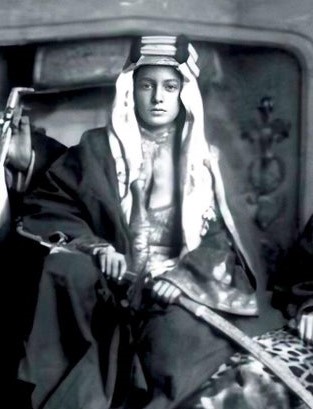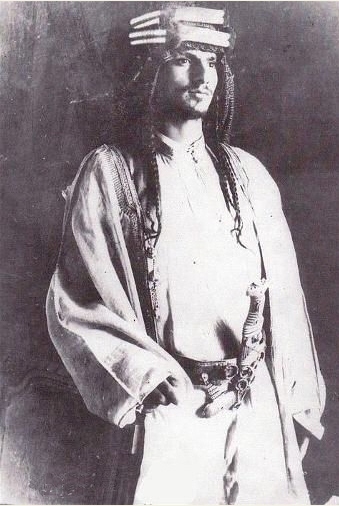|
Muhammad Bin Talāl
Muhammad bin Talal Al Rashid ( ar, محمد بن طلال الرشيد ''Muḥammad bin Ṭalāl Āl Rašīd''; c.1904 – 1954) was the twelfth and last emir of Jabal Shammar in Ha'il. He ruled from early 1920 to 2 November 1921. Reign Muhammad began his rule in early 1921, after the reign of Emir Abdullah bin Mutaib ended, which signaled the end of the Emirate of Jabal Shammar. Abdulaziz Al Saud, Emir of Nejd and future King of Saudi Arabia, made it his goal to include the territory occupied by Jabal Shammar in his nation. Emir Muhammad, the people of Ha'il, and the Shammar and Bani Tamim Banū Tamīm ( ar, بَنُو تَمِيم) is an Arab tribe that originated in Najd in the Arabian Peninsula. It is mainly present in Saudi Arabia, Qatar, Kuwait, Iraq, Jordan, Algeria, and has a strong presence in Morocco, Palestine, Tunisia, ... tribes fought several battles against the Al Saud forces, but Emir Abdulaziz reigned triumphant, and the Emirate of Ha'il (Jabal Shammar) joi ... [...More Info...] [...Related Items...] OR: [Wikipedia] [Google] [Baidu] |
Emirate Of Jabal Shammar
The Emirate of Jabal Shammar ( ar, إِمَارَة جَبَل شَمَّر), also known as the Emirate of Haʾil () or the Rashidi Emirate (), was a state in the northern part of the Arabian Peninsula, including Najd, existing from the mid-nineteenth century to 1921.J. A. Hammerton. ''Peoples Of All Nations: Their Life Today And Story Of Their Past (in 14 Volumes)''. Concept Publishing Company, 2007. Pp. 193. ''Jabal Shammar'' in English is translated as the "Mountain of the Shammar". Jabal Shammar's capital was Ha'il. It was led by a monarchy of the Rashidi dynasty. It included parts of modern-day Saudi Arabia, Iraq, and Jordan. History The Emirate of Jabal Shammar was established in 1836 as vassal of the second Saudi state when the first ruler the emirate Abdullah bin Rashid was appointed as governor of Ha’il by the Saudi Imam Faisal bin Turki. However after the weakening of the second Saudi state, The Rashīdis, rulers of Jabal Shammar, had succeeded in ousting their S ... [...More Info...] [...Related Items...] OR: [Wikipedia] [Google] [Baidu] |
Shammar
The tribe of Shammar ( ar, شَمَّر, Šammar) is a tribal Arab Qahtan confederation, descended from the Yemeni tribe of Tayy as they originated in Yemen before migrating into present day Saudi Arabia, It is the biggest branch of Tayy tribe. It is one of the largest and most influential Arab tribes. The historical and traditional seat of the tribe's leadership is in the city of Ha'il in what was the Emirate of Jabal Shammar in Saudi Arabia. In its "golden age", around 1850, the tribe ruled much of central and northern Arabia from Riyadh to the frontiers of Syria and the vast area known as Al Jazira in Northern Iraq. One of the early famous figures from the tribe was the legendary Hatim Al-Ta'i (Hatim of Tayy; died 578), a Christian Arab renowned for generosity and hospitality who figured in the '' Arabian Nights''. The early Islamic historical sources report that his son, Adiyy ibn Hatim, whom they sometimes refer to as the "king" of Tayy, converted to Islam before Muhammad's ... [...More Info...] [...Related Items...] OR: [Wikipedia] [Google] [Baidu] |
1900s Births
Nineteen or 19 may refer to: * 19 (number), the natural number following 18 and preceding 20 * one of the years 19 BC, AD 19, 1919, 2019 Films * ''19'' (film), a 2001 Japanese film * ''Nineteen'' (film), a 1987 science fiction film Music * 19 (band), a Japanese pop music duo Albums * ''19'' (Adele album), 2008 * ''19'', a 2003 album by Alsou * ''19'', a 2006 album by Evan Yo * ''19'', a 2018 album by MHD * ''19'', one half of the double album ''63/19'' by Kool A.D. * ''Number Nineteen'', a 1971 album by American jazz pianist Mal Waldron * ''XIX'' (EP), a 2019 EP by 1the9 Songs * "19" (song), a 1985 song by British musician Paul Hardcastle. * "Nineteen", a song by Bad4Good from the 1992 album ''Refugee'' * "Nineteen", a song by Karma to Burn from the 2001 album ''Almost Heathen''. * "Nineteen" (song), a 2007 song by American singer Billy Ray Cyrus. * "Nineteen", a song by Tegan and Sara from the 2007 album '' The Con''. * "XIX" (song), a 2014 song by Slipkno ... [...More Info...] [...Related Items...] OR: [Wikipedia] [Google] [Baidu] |
Faisal Of Saudi Arabia
Faisal bin Abdulaziz Al Saud ( ar, فيصل بن عبدالعزيز آل سعود ''Fayṣal ibn ʿAbd al ʿAzīz Āl Suʿūd'', Najdi Arabic pronunciation: ; 14 April 1906 – 25 March 1975) was a Saudi Arabian statesman and diplomat who was King of Saudi Arabia from 2 November 1964 until his assassination in 1975. Prior to his ascension, he served as Crown Prince of Saudi Arabia from 9 November 1953 to 2 November 1964, and he was briefly regent to his half-brother King Saud in 1964. He was prime minister from 1954 to 1960 and from 1962 to 1975. Faisal was the third son of King Abdulaziz, the founder of modern Saudi Arabia, and the second of Abdulaziz's six sons who were kings. Faisal was the son of Abdulaziz and Tarfa bint Abdullah Al Sheikh. His father was still reigning as Emir of Nejd at the time of Faisal's birth, and his mother was from the Al ash-Sheikh family which has produced many prominent Saudi religious leaders. Faisal emerged as an influential royal politician ... [...More Info...] [...Related Items...] OR: [Wikipedia] [Google] [Baidu] |
Faisal Bin Musaid
Faisal bin Musaid Al Saud ( ar, فيصل بن مساعد آل سعود, ''Fayṣal bin Musāʿid ʾĀl Suʿūd''; 4 April 194418 June 1975) was the assassin and nephew of King Faisal of Saudi Arabia. Early life Faisal bin Musa'id was born in 1944. His father was Prince Musa'id bin Abdulaziz, the paternal half-brother to six Saudi kings including King Faisal. His mother was Watfa, a daughter of Muhammad bin Talāl, the 12th and last Rashidi emir. Musa'id and Wafta later divorced. Prince Faisal and his siblings were much closer to their maternal Rashidi relatives than their paternal Al Saud relatives. In 1965, Faisal's older brother Khaled was shot and killed by a Saudi police officer while he led an assault on a new television station in Riyadh that had been recently founded by King Faisal. Some people opposed the establishment of a national television service, as they believed it immoral to produce images of humans. While that is the official version, the details of his ... [...More Info...] [...Related Items...] OR: [Wikipedia] [Google] [Baidu] |
Musaid Bin Abdulaziz Al Saud
Musa'id bin Abdulaziz Al Saud (26 June 1923 – 19 August 2013) was the twelfth son of King Abdulaziz, the founder of Saudi Arabia. He was a businessman and the father of Faisal bin Musaid, the assassin of his half-brother King Faisal. Early life Musa'id was born in 1923. His father was King Abdulaziz and his mother was Jawhara bint Saad bin Abdul Muhsin Al Sudairi. Before marrying King Abdulaziz, Jawhara had been married to his full brother Sa'ad bin Abdul Rahman until the latter's death in the Battle of Kanzan in 1915. After Jawhara's death, her sister Haya also married Abdulaziz. She was the mother of Prince Badr, Prince Abdul Majid and Prince Abdul Illah. Musa'id had two full brothers, Prince Saad and Prince Abdul Muhsin, and one full sister, Princess Al Bandari. Personal life Following the discovery of oil in Saudi Arabia, Musa'id and his brothers began to live in several European cities, including Paris and London among the others. During this period Musa'id was ... [...More Info...] [...Related Items...] OR: [Wikipedia] [Google] [Baidu] |
Bani Tamim
Banū Tamīm ( ar, بَنُو تَمِيم) is an Arab tribe that originated in Najd in the Arabian Peninsula. It is mainly present in Saudi Arabia, Qatar, Kuwait, Iraq, Jordan, Algeria, and has a strong presence in Morocco, Palestine, Tunisia, and Libya. It is also present in many other parts of the Arab world such as Egypt and Khuzestan in Iran. The word ''Tamim'' in Arabic means strong and solid. It can also mean those who strive for perfection. History and origin The traditional family tree of Banu Tamim is as follows: Tamim bin Murr bin 'Id bin Amr bin Ilyas bin Mudar bin Nizar bin Ma'ad bin Adnan - a distant descendant of Isma'il bin Ibrahim (Ishmael, son of Abraham). Banu Tamim is one of the largest tribes of Arabia. The tribe occupied numerous Wadis and villages in central and eastern Arabia in the 6th century before playing an important role with the revelation of Islam. They came into contact with Muhammad in the 8th year of Hijrah, but they did not immediately conve ... [...More Info...] [...Related Items...] OR: [Wikipedia] [Google] [Baidu] |
King Of Saudi Arabia
The king of Saudi Arabia is the monarchial head of state and ruler of Saudi Arabia who holds absolute power. He is the head of the Saudi Arabian royal family, the House of Saud. The king is called the "Custodian of the Two Holy Mosques" (), a title that signifies Saudi Arabia's jurisdiction over the mosques of Great Mosque of Mecca, Masjid al Haram in Mecca and Al-Masjid an-Nabawi in Medina. The title has been used many times through the history of Islam. The first Saudi monarch to use the title was Faisal of Saudi Arabia, King Faisal; however, Khalid of Saudi Arabia, King Khalid did not use the title after him. In 1986, Fahd of Saudi Arabia, King Fahd replaced "Majesty, His Majesty" with the title of Custodian of the Two Holy Mosques, and it has been ever since used by both Abdullah of Saudi Arabia, King Abdullah and Salman of Saudi Arabia, King Salman bin Abdulaziz. History Ibn Saud King Abdul-Aziz (known in the West as Ibn Saud) regained his patrimony, which is known as tod ... [...More Info...] [...Related Items...] OR: [Wikipedia] [Google] [Baidu] |
House Of Rashid
The Rasheed dynasty, also called Al Rasheed or the House of Rasheed ( ar, آل رشيد ; ), was a historic Arabian House or dynasty that existed in the Arabian Peninsula between 1836 and 1921. Its members were rulers of the Emirate of Ha'il and the most formidable enemies of the House of Saud, rulers of the Emirate of Nejd. They were centered in Ha'il, a city in northern Najd that derived its wealth from being on the route of the Hajj pilgrimage to Mecca, and was also a commercial center. The rulers of Ha'il were the sons of Abdullah bin Rashid, founder of the dynasty. History The Rashidi dynasty derived their name from their forebear Abdullah bin Ali Al Rashid, the first emir, who began the establishment of the Emirate of Ha'il. The Rashidi emirs co-operated closely with the Ottoman Empire. However, that co-operation became problematic as the Ottoman Empire lost popularity. In 1890, Al Rashid occupied Riyadh and then defeated the Saudi tribes, who fled into exile, first t ... [...More Info...] [...Related Items...] OR: [Wikipedia] [Google] [Baidu] |
Emir Of Nejd
The Emirate of Nejd or Imamate of Nejd was the Second Saudi State, existing between 1824 and 1891 in Nejd, the regions of Riyadh and Ha'il of what is now Saudi Arabia. Saudi rule was restored to central and eastern Arabia after the Emirate of Diriyah, the First Saudi State, having previously been brought down by the Ottoman Empire's Egypt Eyalet in the Ottoman–Wahhabi War (1811–1818). The second Saudi period was marked by less territorial expansion and less religious zeal, although the Saudi leaders continued to be called Imam and still employed Wahhabist religious scholars. Turki bin Abdullah bin Muhammad's reconquest of Riyadh from Egyptian forces in 1824 is generally regarded as the beginning of the Second Saudi State. Severe internal conflicts within the House of Saud eventually led to the dynasty's downfall at the Battle of Mulayda in 1891, between the forces loyal to the last Saudi imam, Abdul Rahman ibn Faisal ibn Turki, and the Rashidi dynasty of Ha'il. History Th ... [...More Info...] [...Related Items...] OR: [Wikipedia] [Google] [Baidu] |
Abdulaziz Al Saud
Abdulaziz bin Abdul Rahman Al Saud ( ar, عبد العزيز بن عبد الرحمن آل سعود, ʿAbd al ʿAzīz bin ʿAbd ar Raḥman Āl Suʿūd; 15 January 1875Ibn Saud's birth year has been a source of debate. It is generally accepted as 1875, although a few sources give it as 1880. According to British author Robert Lacey's book ''The Kingdom'', a leading Saudi historian found records that show Ibn Saud in 1891 greeting an important tribal delegation. The historian reasoned that a 10 or 11-year-old child (as given by the 1880 birth date) would have been too young to be allowed to greet such a delegation, while an adolescent of 15 or 16 (as given by the 1875 date) would likely have been allowed. When Lacey interviewed one of Ibn Saud's sons prior to writing the book, the son recalled that his father often laughed at records showing his birth date to be 1880. Ibn Saud's response to such records was reportedly that "I swallowed four years of my life." p. 561" – 9 Novembe ... [...More Info...] [...Related Items...] OR: [Wikipedia] [Google] [Baidu] |





